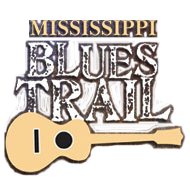Muddy Waters’s Cabin
Muddy Waters’s Cabin - Clarksdale
Muddy Waters lived most of his first thirty years in a house on this site, part of the Stovall Plantation. In 1996, the restored house was put on display at the Delta Blues Museum in Clarksdale. Muddy Waters was first recorded here in 1941 by Alan Lomax, who was compiling songs for the Library of Congress. Muddy Waters is known as the king of Chicago blues.
In August 1941, on a field recording expedition sponsored by the Library of Congress and Fisk University, Alan Lomax and John Work set up portable equipment in Waters’ house to record Muddy and other local musicians, including fiddler Henry “Son” Simms. Lomax returned with Lewis Jones in 1942 for a second series of recordings. Two of Waters’ recordings, “Burr Clover Farm Blues” and “Burr Clover Blues,” paid tribute to plantation owner Colonel William Howard Stovall (1895-1970) and his crop. The Stovalls, one of the Delta’s most successful cotton-farming families, were pioneers of agricultural technology, and Colonel Stovall invented the burr clover seed harvester in 1935. Waters told Lomax that he wrote “Burr Clover Blues” at Stovall’s request. Waters entertained field hands at his house, which served as a juke joint, and also played at social functions for the Stovalls, as did the Mississippi Sheiks, a popular black string band that Waters admired.
Waters’ cousin, The Reverend Willie Morganfield (1927-2003), was born on the Stovall plantation and turned down offers to sing the blues and devoted his talents to the church, becoming a popular gospel recording artist in the 1960s. He was pastor of the Bell Grove Missionary Baptist Church in Clarksdale. Blues singer-pianist Eddie Boyd (1914-1994), who wrote the classic “Five Long Years,” a No. 1 rhythm & blues hit in 1952, was also born on Stovall. Stovall resident and blues bassist David “Pecan” Porter (1943-2003) later lived in the house that Muddy Waters had earlier occupied. Porter was active on the Clarksdale blues scene from the 1960s through the 1990s.
Only in the 1980s, after the vacant house was in disrepair, did tourists begin visiting it as a Muddy Waters shrine. In 1987, guitarist Billy Gibbons of the rock group Z.Z. Top had “Muddywood” guitars crafted from the planks of the house. Z.Z. Top subsequently used the guitars to promote a fund-raising drive to benefit the Delta Blues Museum.
content © Mississippi Blues Commission
[ BACK TO TOP ]

